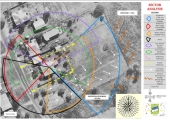posted 7 years ago
G’day All,
‘Felix Agricola’ here to say hello and hopefully contribute in a helpful way to the Forum. The Forum Name roughly translates to ‘Happy Farmer’ in Latin.
I’m from the east coast of New South Wales, Australia - USDA Scale: 10/11, Koppen Index: Cfa (Humid Subtropical).
Long story shortened: commencing in the early 1900’s my Grandparents, Uncles/Aunties, Father, and extended family were the traditional mixed crop farmers and share-croppers, supplementing seasonal work with sugar cane cutting, cane-gang cooks, dairy cattle, and trawler fishermen. No mechanised harvesting, all done by manual labour and horse-driven vehicles.
Dad moved to Sydney just after WW2 for better employment opportunities for him and the future children. However, you can take the man out of the country but you can’t take the country out of the man, so I grew up in suburbia with a backyard full of vegetable gardens, fruit trees, and chooks (chickens).
I had the opportunity to purchase the grandparents farm a while ago so, when retirement finally comes along, will have the opportunity to recreate the traditional mixed farm model but with the modern twist of permaculture knowledge. (In reality, the original farming methods were almost identical to what is now termed ‘Permaculture’.)
At the moment I’m simply trialling ideas on a suburban lot that can be up-scaled for the farm. According to our Bureau of Meteorology, both properties have similar climates but the farm is much further north, so typically hotter in summer and colder in winter because of the rural environment e.g. summer has high humidity and maximum temperatures up to mid-40C (114F) to winter minimums of about -2C (28F). Average annual rainfall just over 1,000mm (42 inches), but, because it receives the tail end of northern cyclones, rainfall can exceed this quite significantly. So, it’s pretty much in the sweet-spot in regards to growing most winter and summer crops.
Generally speaking, the thin compacted surface soil is under laid by red/grey clay = perhaps the best to create a very nutrient rich, high water retaining clay loam. The property has optimal sun orientation – slightly north of an east/west alignment. Slope varies considerably typically requiring contour planting in some places. It also gets afternoon cool sea breezes that quell summer heat.
A typical permaculture forest WILL NOT be achieved simply because the property is neighbouring an extensive wetland and river system that is home to some very venomous snakes e.g. Eastern Brown, Tiger, Taipan, Mulga, Rough Scaled, Death Adder, Red-Bellied Black Snakes, etc, etc. So I don’t want to create a rich habitat for their prey – frogs, lizards, nesting birds. That said, an adjacent section will be planted with a mix of native habitat and forest for Silviculture, so they can slither around that section as much as they like!
Plan on keeping chooks, ducks, geese, turkeys, and perhaps Guinea Fowl. Also a few goats and the smaller breeds of pigs. Need to reinstall water tanks, clean out and repair an existing underground concrete tank my Grandfather installed in the 1940’s, build a new shed and fowl yard, and some other major/minor maintenance works to make the Queenslander type house design 21st Century compatible and efficient.
The farm typically has many heritage plants (both ornamental and food types) that were planted by my ancestors: Macadamia, Mulberry, Guava, Mango, Peach, Orange, Lemon, and a peculiar unidentified type of grape that has a unique flavour.
Anyway, that’s the background, property description and proposals in a nutshell.
Hope to swap ideas and tricks-of-the-trade with other Forum members.
Regards,
‘Felix’









